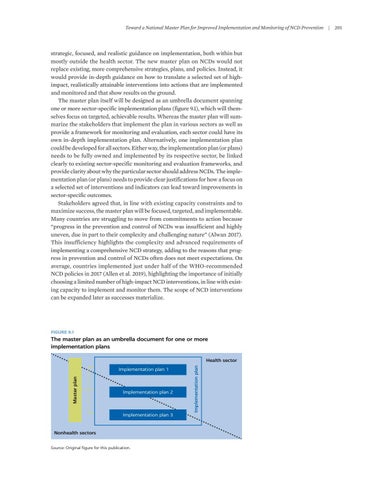Toward a National Master Plan for Improved Implementation and Monitoring of NCD Prevention | 201
strategic, focused, and realistic guidance on implementation, both within but mostly outside the health sector. The new master plan on NCDs would not replace existing, more comprehensive strategies, plans, and policies. Instead, it would provide in-depth guidance on how to translate a selected set of high- impact, realistically attainable interventions into actions that are implemented and monitored and that show results on the ground. The master plan itself will be designed as an umbrella document spanning one or more sector-specific implementation plans (figure 9.1), which will themselves focus on targeted, achievable results. Whereas the master plan will summarize the stakeholders that implement the plan in various sectors as well as provide a framework for monitoring and evaluation, each sector could have its own in-depth implementation plan. Alternatively, one implementation plan could be developed for all sectors. Either way, the implementation plan (or plans) needs to be fully owned and implemented by its respective sector, be linked clearly to existing sector-specific monitoring and evaluation frameworks, and provide clarity about why the particular sector should address NCDs. The implementation plan (or plans) needs to provide clear justifications for how a focus on a selected set of interventions and indicators can lead toward improvements in sector-specific outcomes. Stakeholders agreed that, in line with existing capacity constraints and to maximize success, the master plan will be focused, targeted, and implementable. Many countries are struggling to move from commitments to action because “progress in the prevention and control of NCDs was insufficient and highly uneven, due in part to their complexity and challenging nature” (Alwan 2017). This insufficiency highlights the complexity and advanced requirements of implementing a comprehensive NCD strategy, adding to the reasons that progress in prevention and control of NCDs often does not meet expectations. On average, countries implemented just under half of the WHO-recommended NCD policies in 2017 (Allen et al. 2019), highlighting the importance of initially choosing a limited number of high-impact NCD interventions, in line with existing capacity to implement and monitor them. The scope of NCD interventions can be expanded later as successes materialize.
FIGURE 9.1
The master plan as an umbrella document for one or more implementation plans
Master plan
Implementation plan 1
Implementation plan 2
Implementation plan 3
Nonhealth sectors Source: Original figure for this publication.
Implementation plan
Health sector
